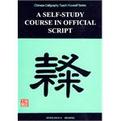中国书法自学丛书-隶书自学教程
出版时间:1998-1 出版社:华语教学 作者:黄全信 编著 页数:152
内容概要
Chinese calligraphy, the core of the Oriental arts, reflects the temperament of the Chinese nation. The black and white, dots and lines are an expression of the spirits and images of Nature, reflecting a calligrapher's feelings and knowledge. Calligraphy's profound artistic essence lies in the combination of feeling and rationale, form and spirit, rich structure and vivid rhythm - a perfect balance between the form and the ideological content expressed in a character. Though devoid of color, calligraphy is variously colored as painting; and without sound, it contains melodies just like music. Chinese calligraphy has a long history, ranging from the keeping of records by tying knots before Cang Jie invented writing, to the characters on earthenware discovered at Dawenkou and inscriptions on bones or tortoise shells of the Shang Dynasty (c. 16th-1 lth century BC). Like a long running river, Chinese calligraphy has evolved during thousands of years, characterized by simplicity and unsophistication in the Shang and Zhou dynasties (c. 16th century-221 BC),splendor in the Qin and Hart dynasties (221 BC-AD 220), graceful bearing in'the Wei and Jin dynasties (220-420), magnificence in the Sui and Tang dynasties (581-907), radiating vigor in the Song and Yuan dynasties (960-1368), prosperity in the Ming and Qing dynasties (1368-191 l) and grandeur in the current era. Chinese characters fall into the following styles: regular, running, grass, official and seal scripts. Seal scripts may be divided into large and small characters; official scripts, into Qin and Hart styles; grass characters, into Zhang (cursive official), Jin (modem) and Kuang (wild) scripts; and regular characters, into Wei and Tang scripts. Chinese calligraphy not only reflects the character of individual calligrapher, but also presents the styles and flavors of different regions and eras. China has always regarded calligraphy as the quintessence of Chinese culture and a nationaltreasure as well. Calligraphy is a required course at school and every educated person must study calligraphy.
书籍目录
Chapter I Official Script 1. Origin and Development 2. Qin Official Script 3. Simplified Han Official Script 4. Han Official ScriptChapter II Techniques of Writing 1. Sitting Position 2. Standing Position 3. Holding the Brush 4. Movement of the BrushChapter III Strokes 1. Basic Strokes 2. Complex Strokes 3. The Changes of Strokes 4. The Order of StrokesChapter IV Radicals 1. Character's Head 2. Character's Bottom 3. Left Component 4. Right Component 5. Character's Frame 6. ChangesChapter V Structure 1. Structural Forms 2. Outline of the Structure 3. The Laws of the Structure 4. The Characteristics of the Structure 5. Changes in the Structure Chapter VI Tracing and Copying 1. Four-square Frame 2. Diagonal-marked Frame 3. Nine-square Frame 4. Two-square FrameChapter VII The Art of Composition 1. Various Forms of Scrolls 2. Text……
图书封面
评论、评分、阅读与下载
用户评论 (总计0条)
相关图书
- 中国书法自学教程.行书自学教程(英文教程)
- 中国书法自学丛书-魏碑自学教程
- 中国书法自学教程.篆书自学教程(英文教程)
- 心灵的选择(满分卷):2002高考作文特快专递//方洲新概念
- 丑小鸭历险记(16)/西班牙系列动画片
- 孩子们都喜欢的100个童话-野草莓卷
- 情感人生
- 港台歌星系列—明星大写意
- 青少年必读:古今中外名人传
- 曾国藩传世经典(全十四册)套书(特价)
- 夏夜集
- 陈汉昌书法作品集
- 新编书法字汇(全五册)
- 珍惜权力
- 电子设计自动化实践与训练
- PHP开发Wed网站实例导学
- 虎兕志
- 留学美利坚
- 缔造强者:中国跨国公司成长的现实选择 (平装)
- 轻松学Photo Draw2000
- 3DS MAX 4.0实例精粹三维动画制作入门实践
- 军事奥秘解疑太空兵器
- 世纪风玲
- 沈尧伊风景画
- 当代中国美术家档案(上下)
